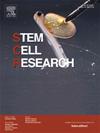从携带TSC1基因突变的患者身上建立人类诱导多能干细胞(iPSC)系
IF 0.7
4区 医学
Q4 BIOTECHNOLOGY & APPLIED MICROBIOLOGY
引用次数: 0
摘要
结节性硬化症复合体1 (TSC1)基因编码生长抑制蛋白,并在临床上与结节性硬化症复合体(TSC)和相关癫痫有关。在这项研究中,我们提出了一种来自癫痫和结节性硬化症患者的诱导多能干细胞(iPSC)系,其携带TSC1 c.2626-2(IVS20) a >;G变异。患者外周血单个核细胞被成功重编程为iPSCs, iPSCs保持了正常核型,表达了hPSCs的标记物,并在体内证明了向所有三种胚层分化的能力。该iPSC系可作为研究癫痫发病机制的宝贵资源。本文章由计算机程序翻译,如有差异,请以英文原文为准。
Establishment of a human induced pluripotent stem cell (iPSC) line from a patient harboring a TSC1 gene mutation
The tuberous sclerosis complex 1 (TSC1) gene encodes for the growth inhibitory protein, hamartin, and has been clinically implicated in tuberous sclerosis complex (TSC) and associated epilepsy. In this study, we present an induced pluripotent stem cell (iPSC) line derived from a patient with epilepsy and tuberous sclerosis, carrying the TSC1 c.2626-2(IVS20) A > G variant. Peripheral blood mononuclear cells from the patient were successfully reprogrammed into iPSCs, which maintained a normal karyotype, expressed markers of hPSCs, and demonstrated the ability to differentiate into all three germ layers in vivo. This iPSC line serves as a valuable resource for investigating the pathogenic mechanisms underlying epilepsy.
求助全文
通过发布文献求助,成功后即可免费获取论文全文。
去求助
来源期刊

Stem cell research
生物-生物工程与应用微生物
CiteScore
2.20
自引率
8.30%
发文量
338
审稿时长
55 days
期刊介绍:
Stem Cell Research is dedicated to publishing high-quality manuscripts focusing on the biology and applications of stem cell research. Submissions to Stem Cell Research, may cover all aspects of stem cells, including embryonic stem cells, tissue-specific stem cells, cancer stem cells, developmental studies, stem cell genomes, and translational research. Stem Cell Research publishes 6 issues a year.
 求助内容:
求助内容: 应助结果提醒方式:
应助结果提醒方式:


